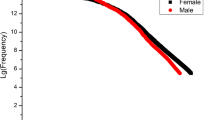Abstract
One widely used model of knowledge representation is that of a network in which concepts are portrayed as nodes with links between the nodes representing associations. Schvaneveldt (1990) developed a method (Pathfinder) that generates associative networks from individual's ratings of similarity of word pairs. We had 51 female and 47 male undergraduates rate for similarity all paired combinations of 16 words judged as relevant to the domain of sexuality. Using a measure of network similarity, we found that each gender's networks were more similar to each other than they were to the other gender's. Using the number of links on works as the dependent variable there were gender differences in the number of links within clusters of words, between clusters of words, and on specific words. These differences, for the most part, are consistent with gender stereotypes and prior research showing gender differences in the processing of sexual information.
Similar content being viewed by others
References
Byrne D., and Byrne, L. (1977).Exploring Human Sexuality, Thomas G. Crowell, New York.
Collins, A. M., and Loftus, E. (1975). A spreading activation theory of semantic memory.Psychol Rev. 82: 407–428.
DeLamater, J. (1987) A sociological approach. In Geer, J. H. and O'Donohue, W. T. (eds.),Theories of Human Sexuality. Plenum Press, New York, pp. 237–255.
Fisher, W., Byrne, D., White, L., and Kelley, K. (1988). Erotophobia-erotophilia as a dimension of personality.J. Sex Res. 25: 123–151.
Gagnon, J. H., and Simon, W. (1973).Sexual Conduct: The Social Sources of Human Sexuality, Aldine, Chicago, IL.
Geer, J. H., and Bellard, H. (in press). Sexual content induced delays in lexical decisions.Arch. Sex. Behav.
Geer, J. H., and McGlone, M. (1990). Sex differences in memory for erotica.Cognit. Emot. 4: 71–78.
Geer, J. H., and Melton, J. S. (in press). Sexually ambiguous lexical decisions.Arch. Sex. Behav.
Gross, A. E. (1978). The male role and heterosexual behavior.J. Soc. Issues 34: 87–107.
Mosher, D. L. (1991). Macho men, machismo, and sexuality. In Bancroft, J., Davis, C. M. and Ruppel, H. J. J. (eds.),Annual Review of Sex Research, vol. 2, Stoyles Graphic Services, Lake Mills, IA, pp. 199–247.
Quillian, M. (1967). Word Concepts: A theory and simulation of some basic semantic capabilities.Behav Sci. 12: 410–430.
Schmidt, G., Sigusch, V., and Schafer, S. (1973). Responses to reading erotic stories: Male-female differences.Arch. Sex. Behav. 2: 181–199.
Schvaneveldt, R. W. (ed.). (1990).Pathfinder Associative Networks: Studies in Knowledge Organizatiion, Ablex, Norwood, NJ.
Symons, D. (1987). An evolutionary approach. In Geer, J. H., and O'Donohue, W. T. (eds.),Theories of Human Sexuality, Plenum Press, New York, pp. 91–125.
Wiseman, J. (1976).The Social Psychology of Sex. Harper & Row, New York.
Author information
Authors and Affiliations
Rights and permissions
About this article
Cite this article
Geer, J.H. Gender differences in the organization of sexual information. Arch Sex Behav 25, 91–107 (1996). https://doi.org/10.1007/BF02437908
Issue Date:
DOI: https://doi.org/10.1007/BF02437908




